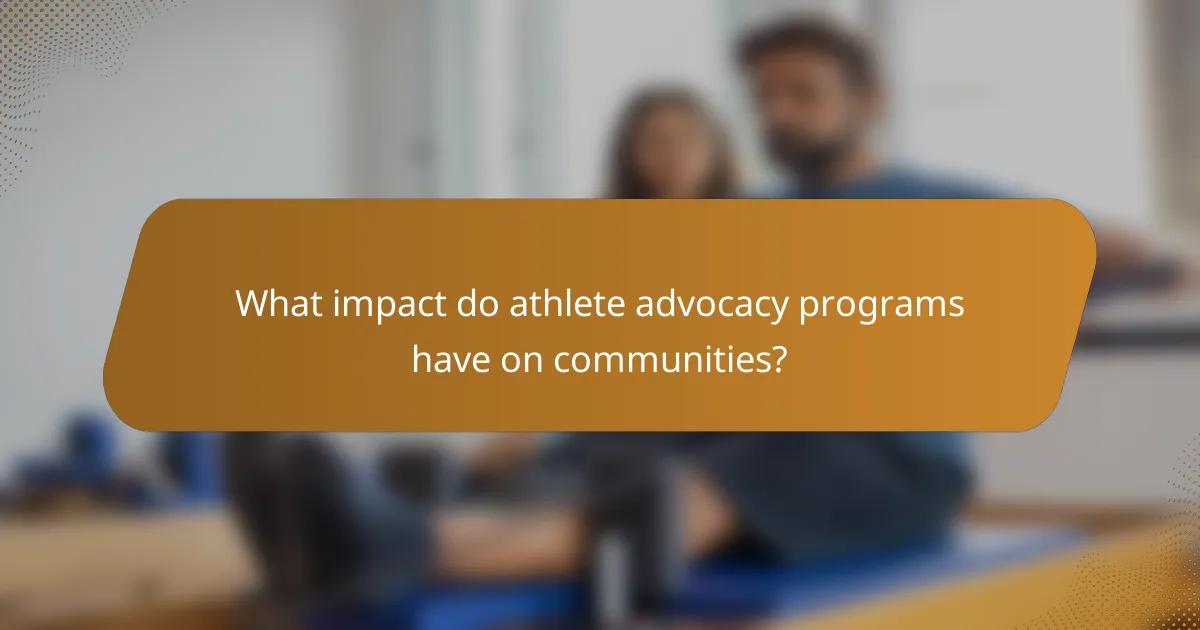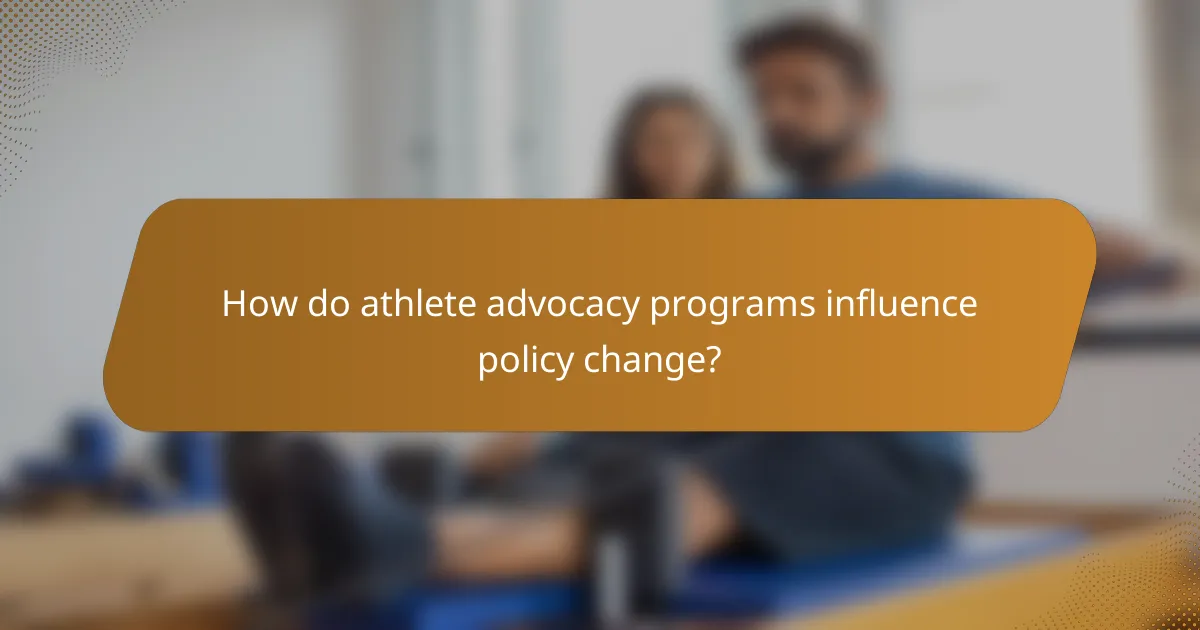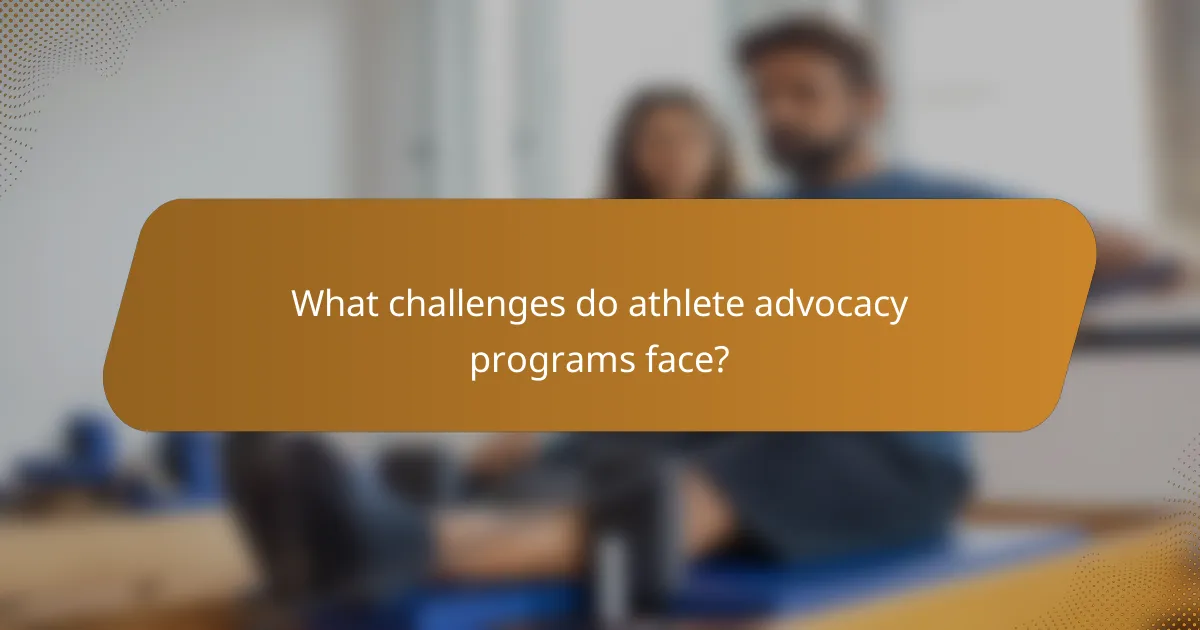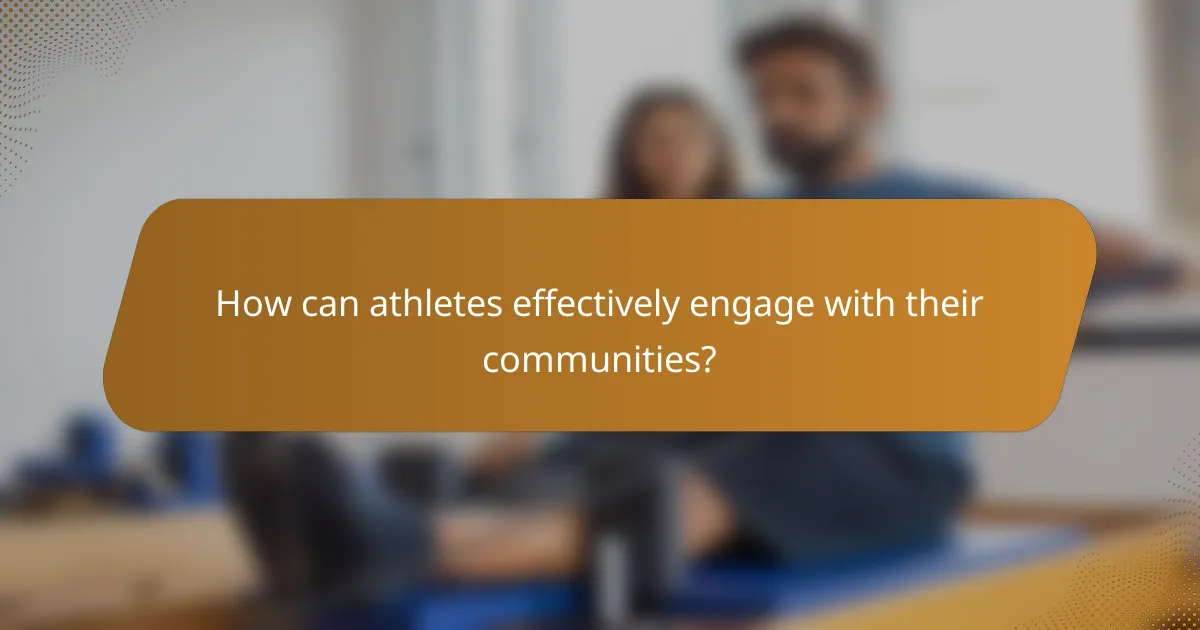Athlete advocacy programs significantly enhance athlete welfare and community engagement while influencing policy changes. These initiatives empower athletes to address critical issues, promote mental health awareness, and foster social change. They also mobilize resources for youth sports and encourage civic participation, ultimately benefiting the entire sports ecosystem. The effectiveness of these programs hinges on strong leadership, community involvement, and tailored messaging.

What are the key benefits of athlete advocacy programs?
Athlete advocacy programs provide essential benefits by promoting athlete welfare, enhancing community engagement, and influencing policy changes. These programs empower athletes to voice their concerns, leading to improved mental health support and safer sporting environments. They foster a sense of community, connecting athletes with fans and stakeholders to drive positive change. Furthermore, advocacy efforts can result in policy reforms that prioritize athlete rights and safety, ultimately benefiting the entire sports ecosystem.
How do these programs enhance athlete welfare?
Athlete advocacy programs enhance athlete welfare by promoting mental health, providing resources, and fostering community support. These initiatives create safe environments, allowing athletes to voice concerns and access vital services. For example, programs often include mental health workshops, peer support networks, and educational resources, which collectively contribute to improved athlete well-being. As a result, athletes experience increased confidence and reduced stress, ultimately leading to better performance and satisfaction in their sports careers.
Which skills do athletes develop through advocacy?
Athletes develop skills such as leadership, communication, and advocacy through athlete advocacy programs. These programs enhance their ability to influence change and engage with communities effectively. Leadership skills are honed as athletes represent causes, while communication skills improve through public speaking and outreach activities. Advocacy fosters a sense of responsibility, encouraging athletes to use their platforms for social good.

What impact do athlete advocacy programs have on communities?
Athlete advocacy programs significantly enhance community well-being by promoting social change and engagement. These initiatives empower athletes to address local issues, raise awareness, and inspire action.
Programs often focus on health, education, and equality, creating positive outcomes. For instance, athletes mobilize resources for youth sports, improving physical fitness and teamwork skills. They also advocate for mental health awareness, helping reduce stigma and providing support networks.
The impact extends to fostering community pride and unity. When athletes champion local causes, they attract attention and resources, benefiting the entire community. Their influence encourages civic participation, leading to improved local policies and initiatives.
In summary, athlete advocacy programs serve as catalysts for community development, enhancing social cohesion and addressing critical issues effectively.
How do these programs foster community engagement?
Athlete advocacy programs foster community engagement by creating platforms for athletes to connect with local issues. These programs empower athletes to lead initiatives that address social concerns, enhancing awareness and participation. As a result, communities benefit from increased collaboration and support for various causes. Programs often include workshops, events, and outreach activities that promote unity and shared goals.
What role do local organizations play in athlete advocacy?
Local organizations play a crucial role in athlete advocacy by providing support, resources, and a platform for athletes to voice their concerns. They facilitate community engagement and promote initiatives that empower athletes. These organizations often collaborate with athletes to address issues like health, safety, and equity in sports. As a result, they help foster a more inclusive and supportive environment for athletes at all levels.

How do athlete advocacy programs influence policy change?
Athlete advocacy programs significantly influence policy change by amplifying athlete voices and promoting social justice initiatives. These programs engage athletes in policy discussions, thereby fostering community awareness and encouraging legislative reforms. For example, initiatives like the Professional Athletes Coalition have successfully lobbied for changes in mental health policies and athlete safety regulations. Such advocacy not only empowers athletes but also creates a ripple effect, inspiring other stakeholders to prioritize athlete welfare. The unique attribute of these programs lies in their ability to unite diverse athlete perspectives, enhancing their impact on policy outcomes.
Which successful case studies highlight policy advancements?
Successful case studies of athlete advocacy programs show significant policy advancements in sports governance. For instance, the NCAA’s adoption of new regulations for athlete compensation reflects athlete input, enhancing their rights. The U.S. Olympic and Paralympic Committee’s Athlete Advisory Council has influenced policies on mental health resources, ensuring athletes’ well-being. Additionally, initiatives like the “Athletes for Hope” program have successfully advocated for inclusion and diversity in sports policies, fostering community engagement. These examples illustrate how athlete advocacy shapes progressive policy changes within sports organizations.
What strategies do athletes employ to advocate for change?
Athletes employ various strategies to advocate for change, focusing on community engagement and social impact. They leverage their platforms to raise awareness about pressing issues, such as mental health, diversity, and environmental sustainability. Collaborative partnerships with non-profits enhance their advocacy efforts, allowing them to reach broader audiences. Additionally, athletes often participate in campaigns that promote policy changes, using their influence to drive meaningful discussions. Engaging in community service projects further solidifies their commitment to social responsibility, fostering a positive impact beyond sports.

What are the unique attributes of successful athlete advocacy programs?
Successful athlete advocacy programs feature unique attributes that enhance their effectiveness. These attributes include strong leadership, community involvement, tailored messaging, and measurable outcomes.
Strong leadership drives the vision and direction of the program, ensuring alignment with athlete values. Community involvement fosters trust and support, creating a network of advocates. Tailored messaging resonates with specific audiences, increasing engagement and impact. Measurable outcomes demonstrate success and guide future initiatives.
These unique traits distinguish effective programs from others, contributing to their overall success in advocating for athletes’ rights and well-being.
How do cultural differences shape advocacy approaches?
Cultural differences significantly influence advocacy approaches in athlete advocacy programs. These variations shape communication styles, values, and community engagement strategies. For instance, collectivist cultures may emphasize group benefits, while individualistic cultures focus on personal achievements. Understanding these distinctions enhances program effectiveness and fosters inclusive environments. Programs tailored to cultural contexts can improve athlete support and community involvement, ultimately leading to greater impact and sustainability.
What innovative methods are used in advocacy initiatives?
Athlete advocacy programs utilize innovative methods such as social media campaigns, community workshops, and partnerships with non-profits. These initiatives enhance visibility, educate the public, and foster community engagement. For example, athletes often share personal stories to connect with audiences, driving awareness of social issues. Additionally, collaborative events with local organizations amplify outreach and impact, creating a supportive network for advocacy efforts.

What challenges do athlete advocacy programs face?
Athlete advocacy programs face several challenges that hinder their effectiveness. Funding limitations restrict program reach and sustainability. Additionally, athlete engagement varies, affecting participation and impact. Navigating legal and regulatory issues complicates advocacy efforts. Lastly, public perception and awareness can limit support and understanding of these initiatives.
How do funding issues affect program sustainability?
Funding issues significantly hinder the sustainability of athlete advocacy programs. Limited financial resources constrain program development, outreach, and community engagement efforts. Programs may struggle to maintain staff, resources, and services, leading to reduced impact on athletes and communities. Consistent funding is crucial for long-term success, enabling programs to adapt and grow.
What are common misconceptions about athlete advocacy?
Many misconceptions exist regarding athlete advocacy, including the belief that it only benefits high-profile athletes. In reality, advocacy programs support athletes at all levels by promoting mental health, inclusion, and community engagement. Another misconception is that these programs are solely focused on sports-related issues; they also address broader social concerns, such as equality and environmental sustainability. Some people think that athlete advocacy is limited to personal branding, but it often fosters collective action for systemic change. Lastly, there is a belief that advocacy efforts are ineffective; however, numerous studies show positive impacts on policy and community awareness.

How can athletes effectively engage with their communities?
Athletes can effectively engage with their communities through advocacy programs that promote social issues. These programs enhance community connections and foster positive change.
Athlete advocacy programs provide numerous benefits, including increased awareness of critical issues, improved community relations, and opportunities for collaboration. For instance, athletes can leverage their platforms to support education, health initiatives, or social justice causes, which resonates with fans and local communities.
The impact of these programs extends beyond individual athletes. They can mobilize resources, inspire community action, and create lasting partnerships with organizations. As a result, athletes become role models, encouraging others to participate in community service and advocacy efforts.
Effective engagement strategies include hosting events, participating in local initiatives, and using social media to amplify their messages. By doing so, athletes can create a significant positive impact and strengthen their ties with the community.
What are best practices for community outreach?
Engaging communities through athlete advocacy programs involves several best practices. First, establish clear objectives that align with community needs. Building relationships with local organizations enhances trust and collaboration. Utilize social media platforms for outreach, ensuring consistent messaging. Encourage athlete involvement to foster authenticity and relatability. Regularly assess impact through feedback and adapt strategies accordingly.
How can social media amplify advocacy efforts?
Social media amplifies advocacy efforts by increasing visibility, fostering community engagement, and enabling real-time communication. Athlete advocacy programs leverage these platforms to share personal stories and mobilize support for causes. This approach enhances the impact of initiatives, as athletes can reach diverse audiences and inspire action. Engaging content, such as videos and live streams, further strengthens connections with followers, driving community involvement. Social media’s shareability allows messages to spread rapidly, creating a ripple effect that can lead to significant change.
What common mistakes should athletes avoid in advocacy?
Athletes should avoid common mistakes like neglecting research, lacking clear messaging, ignoring audience engagement, and failing to collaborate with experts. These missteps can undermine the effectiveness of advocacy efforts.
Neglecting research leads to uninformed positions. Clear messaging ensures that the advocacy resonates with the audience. Engaging the audience fosters community support. Collaborating with experts enhances credibility and impact.
